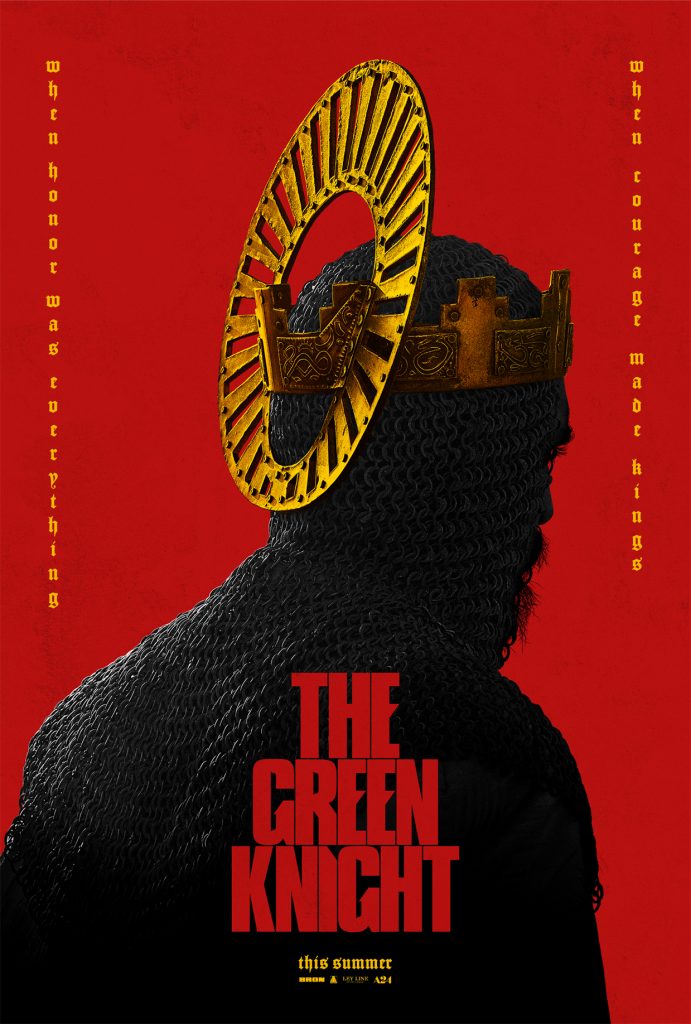The Green Knight—A Tale Tried, Tested, and Inverted
 by Ted Giese
by Ted Giese
This eerie and foreboding retelling of the epic late 14th-century Middle English poem Sir Gawain and the Green Knight is a purposeful inversion of the long-studied and revered anonymous work. While it diverges at some points from the general narrative of the original poem—which Gawain purists will dislike—it goes even further, reversing almost all of the story’s elements. This raises the question: to what end? In this, The Green Knight presents an unanswered mystery.
The general story of both the poem and David Lowery’s film is that of a beheading game and an exchange-of-winnings game. On Christmas, a mysterious Green Knight with a menacing ax comes to the court of King Arthur in Camelot. While all are seated at the round table celebrating the birth of Christ, the Green Knight challenges Arthur and his knights to a game. The Green Knight will allow a single blow from one of the assembled knights and then he will return that blow if he can. The Green Knight kneels and offers up his neck. Gawain, King Arthur’s nephew, accepts the challenge and cuts off the Green Knight’s head, but to the surprise of everyone the Knight picks up his head and tells Gawain that one year hence he will return the blow at the Green Chapel.
As the following year nears its close, Gawain sets out to find the Green Knight and the chapel. With only a few days until the appointment, Gawain finds himself in the castle of Lord Bertilak who engages him in an exchange-of-winnings game. Each day the Lord goes hunting he will give Gawain the best of what he catches and in return Gawain gives to the castle’s Lord what he gains that day. The Lord’s wife daily tries to entrap Gawain sexually but he resists her advances. They exchange kisses and Gawain withholds from the Lord the last gift from the Lady of the castle—a green sash she claims will protect against any attack. With the sash about his waist, Gawain departs to face the Green Knight and his doom.
The film follows the same general narrative of the poem, and yet it also inverts it. The poem, for example, is about a knight who despite having his virtue tested succeeds in remaining a knight— albeit a repentant one. The film however is about a man who gains virtue through the testing process itself, only becoming a true knight in the end. In the poem Gawain is a courageous knight before the story begins; in the film, Gawain is dubbed a knight only after facing the prospect of death honestly. In the poem, Gawain is generous, courteous, chaste, friendly, and devout; in the film he is agnostic at best, socially awkward, unchaste, discourteous, and covetous. He is selfless in the poem; in the film, he is generally selfish. He succeeds in the face of adversity in the poem; in the film, he is dragged along kicking and screaming by the plot until the film’s final frames.
The film’s title—The Green Knight—in a sense then serves a dual meaning: it refers of course to the Knight whom Gawain is seeking. But it can also refer to Gawain as being “green” in terms of his personal experience as a knight.
Inverted Myth
Lowery goes out of his way to obfuscate who the surrounding characters in the film are. He doesn’t give the audience any indications that the king is Arthur or that his queen is Guinevere. Gawain’s mother in the film is Morgan le Fay, King Arthur’s half-sister and sorceress, but she is never referred to by name (in the poem she would be Gawain’s aunt not his mother). Merlin is there too but has no dialogue and no one says his name. On the one hand this shifts attention onto Gawain and away from anything the audience knows about Arthurian legend. On the other hand, it creates a situation where only those in the know truly understand what’s going on. That last part is a kind of occulting: a purposeful hiding in plain sight. When someone in the know figures out who all these people, they are confronted with the fact that Lowery has presented them differently than they appear in the poem. Is this a commentary on the danger of trusting myths? Or is it something else?
While it diverges at some points from the general narrative of the original poem—which Gawain purists will dislike—it goes even further, reversing almost all of the story’s elements. This raises the question: to what end?
Why is Gawain a novice knight in this film rather than one already tested and true? Putting the best construction on Lowery’s motivations, we might suggest this change in Gawain’s character is a response to a world in which people are seldom challenged to struggle against temptation. For audiences today, a more believable story might be one in which a character learns hard truths by experience.
But this interpretation is difficult to accept given the pattern of inversion elsewhere in the film. In the poem Christmas is described with exuberance, mirth, and colour; in the film it is drab, grey, and dour. Arthur in the poem is young and virtuous; in the film he is old and weak in body and spirit. In the poem going to church is a delight; in the film it is a nuisance and the butt of jokes. In the poem Gawain sets out in fine armour and knightly regiments, carrying a shield decorated on the inside with a painting of the Virgin Mary and Christ Child. He fights dragons and monsters of all sorts successfully before arriving at Bertilak’s castle; in the film Gawain is quickly set upon by a scavenger and his fellow thieves. He is accosted, robbed, and left for dead, his beautifully painted shield broken and left as trash by Gawain’s assailants. Even the Green Knight, who in the poem is a man decked in fine green-glowing kingly attire, flaming red eyes, and set as an equal with Arthur, is a monster in the film made of bark and branch, twig and root with clear and keen eyes like a man.
The list of changes goes on and on, even as the overall story follows the general plot of the poem. This is often called “re-imagining” or a “deconstruction,” but Lowery doesn’t just deconstruct he re-constructs presumably to suit his purpose. But what is that purpose? Is it criticism of virtue? Is it a parody of the original text? Is it a slight against the poem’s Christian themes and the rigour of Christian piety in favour of paganism?
The list of changes goes on and on, even as the overall story follows the general plot of the poem. This is often called “re-imagining” or a “deconstruction,” but Lowery doesn’t just deconstruct he re-constructs presumably to suit his purpose.
At a critical moment in the film, when the Lady Bertilak (another character left nameless in the film) is about to give Gawain the green sash, she asks Gawain a key question: “Do you believe in magic?” The Christian response should be: “I believe it to be evil and forbidden by God.” But both the Gawain of the poem and the film take the sash to their shame. In the film, however, Lowery adds an additional dimension to the choice: the sash is soiled during the third of the Lady’s sexual advances toward Gawain. Moreover, in another departure from the poem, the sash in the film turns out to have been previous given to Gawain by his mother Morgan le Fay before he left on his quest. It was stolen by the scavengers earlier in the film. (As an aside, the Lady Bertilak and a prostitute with whom Gawain has in the beginning of the film are played by the same actress, further painting Gawain as sexually impure and unchaste from the beginning of the film right through to this critical moment.)
Introspective Horror
The question “Do you believe in magic?” when taken in the context of Lowery’s constant inversion of the original story, along with additions like a talking spirit/animal guide in the form of a fox, suggests that the whole film is a kind of sigil magic; a kind of symbolic rich celluloid spell cast to some private end. Lowery is certainly no stranger to the occult. He directed two episodes of the CBS All Access TV Series Strange Angel (2018) about Jack Parsons, pioneering rocket engineer and scientist in 1940s Los Angeles, who was a follower of British occultist Aleister Crowley. The Green Knight’s production company A24 also produced Ari Aster’s 2019 film Midsommar and 2018 film Hereditary, as well as Robert Eggers’ 2015 film The Witch and 2019 film The Lighthouse, along with other sophisticated art-house-style “elevated” horror films.
Indeed, within the first few minutes of The Green Knight, Lowery clues in the audience that this film is going to be less high adventure like The Lord of the Rings and more an introspective psychological horror film like the ones previously mentioned. These films are cut from the same cloth in many ways and the association is worth noting. The Green Knight is certainly less gory, but it shares similar attributes to these films, including their approach to the occult and magic.
One final note on inversions. For them to have meaning, one needs to first presuppose the truth of the thing being inverted. So, while Christianity is subverted and downplayed in The Green Knight, some of the poem’s original Christian content remains to haunt the film. Interested viewers coming at the film cold with no knowledge of the poem may find themselves reading Sir Gawain and the Green Knight out of curiosity and will find something altogether different from what they watched.
Because of the film’s suspicious nature, it’s hard to recommend. Christian viewers should consider it with great caution and contemplation. As a film The Green Knight is not interested in yielding its secrets.

With a 14A/R rating, this certainly not a film for young viewers. Some viewers will also find the movie’s slow burn, with an often discordant soundtrack, off-putting. Those wishing to watch a less ominous—but campier—take on the story should check out Stephen Weeks’ 1984 film Sword of the Valiant, starring Sean Connery as the Green Knight.
———————
Rev. Ted Giese is lead pastor of Mount Olive Lutheran Church, Regina, Saskatchewan, Canada; a contributor to The Canadian Lutheran, Reporter; and movie reviewer for the “Issues, Etc.” radio program. For more of his television and movie reviews, check out the Lutheran Movie Review Index.





